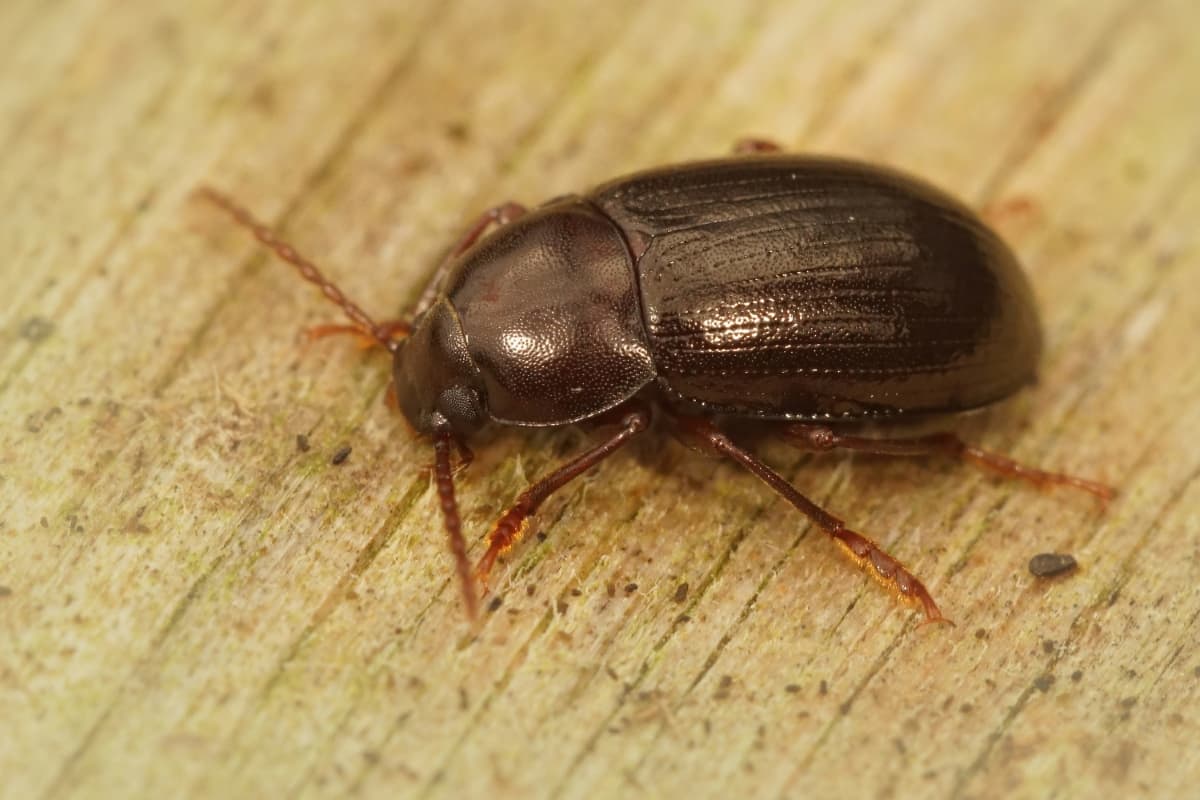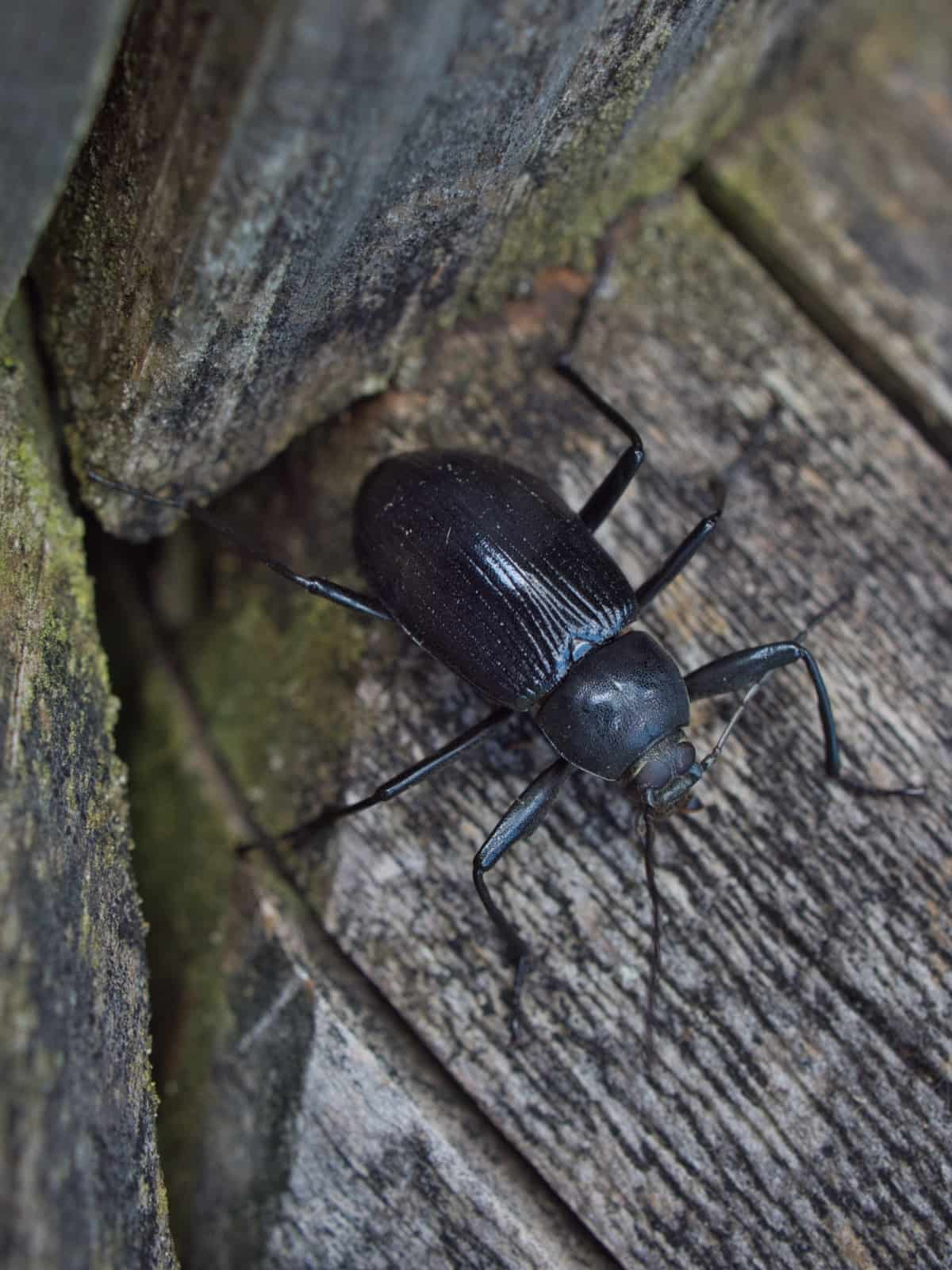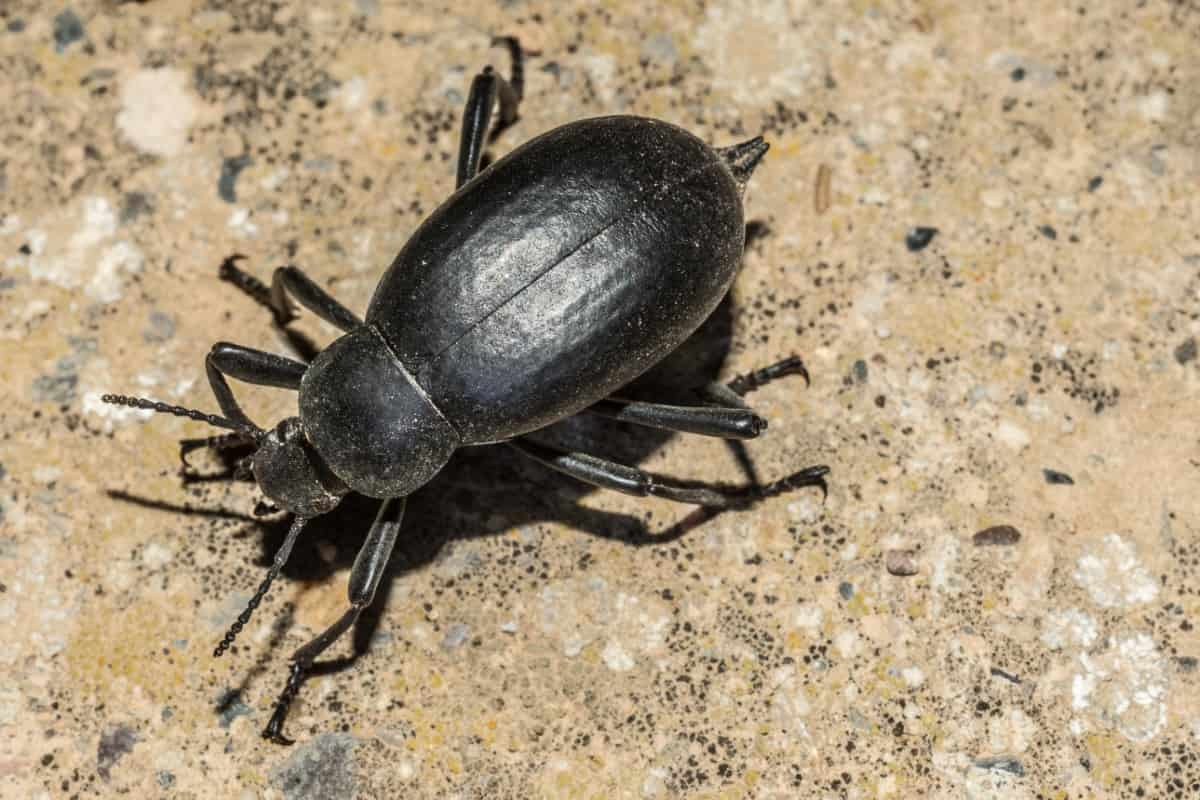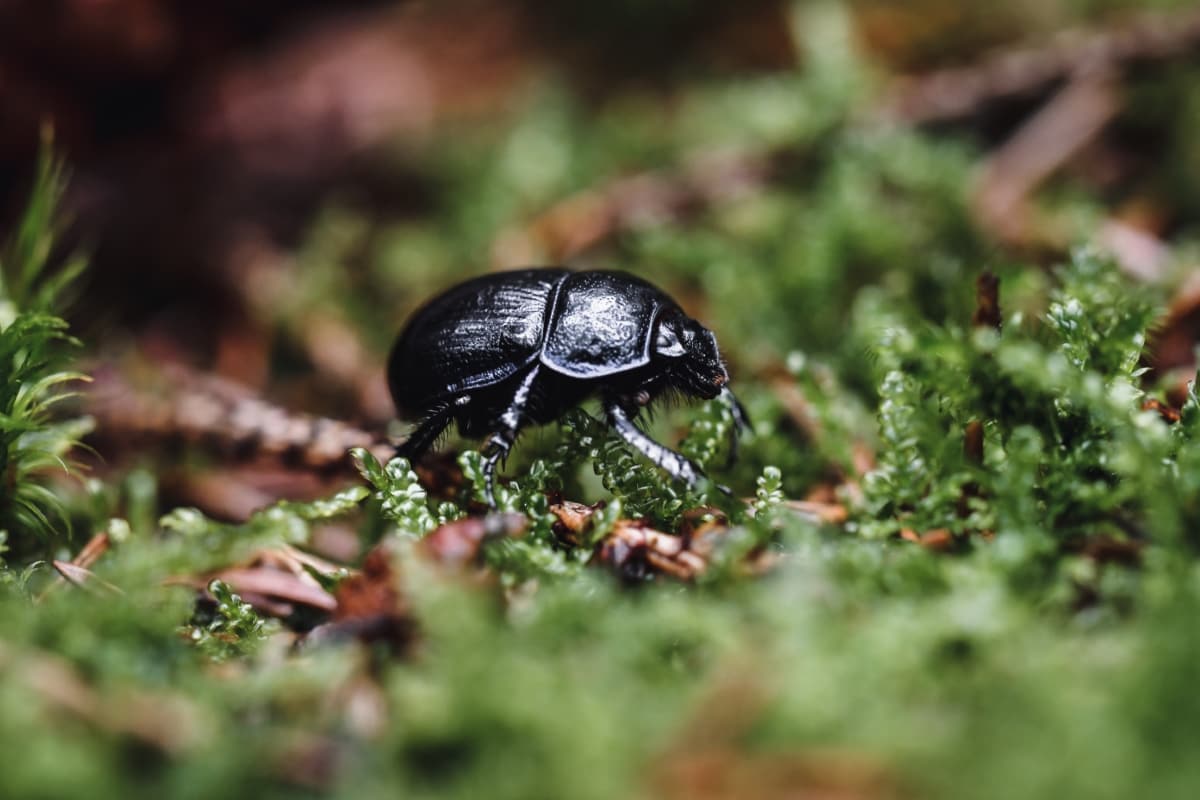Darkling beetles, commonly known as mealworms in their larval stage, are a prevalent pest in agricultural settings, homes, and businesses worldwide. These small, dark-colored beetles belong to the Tenebrionidae family and thrive in warm, dry environments. They infest stored grains, poultry houses, and even households, posing a threat to food supplies and causing structural damage.

Darkling beetles have a diverse habitat range, adapting to various climates and conditions. They prefer dark, secluded areas with organic matter, such as decaying plants or animal waste. In this guide, we’ll explore Darkling Beetle control methods, ensuring the protection of crops, livestock, and property.
How to Get rid of Darkling Beetles
Identifying Darkling Beetle Infestations
Signs and Symptoms of Their Presence
One prominent signs of darkling beetle infestation is the adult beetles or their larvae in and around stored grain bins, poultry houses, or other areas with organic matter. These beetles are typically dark brown or black and about half an inch in length. Additionally, observing damaged grains, fecal pellets, or shed exoskeletons in storage areas indicates their activity.
Furthermore, Darkling beetles emit a distinct, musty odor, particularly in large populations. This odor can help in identifying infested areas even before visual confirmation of the beetles. Regular monitoring of storage facilities, poultry houses, and other susceptible areas is crucial for the early detection and eliminating Darkling Beetles.
The Life Cycle of Darkling Beetles
Key Stages in Darkling Beetle Development
Egg Stage: Darkling beetles begin their life cycle as eggs, which are typically laid in clusters in suitable habitats such as soil, organic matter, or stored grains.
Larval Stage: After hatching from eggs, darkling beetles enter the larval stage, known as mealworms. Mealworms are voracious feeders and cause significant damage to stored grains, wooden structures, and other organic matter.
Pupal Stage: When the larval stage is complete, mealworms pupate into adult beetles. Pupation occurs in soil or other suitable substrates, where larvae undergo metamorphosis.
Adult Stage: The adult darkling beetles emerge from pupae and are capable of reproducing, starting the cycle anew. Adult beetles continue to feed and reproduce, perpetuating the infestation if not controlled.
Preventive Measures Against Darkling Beetles
Strategies to Deter Darkling Beetles from Your Space
Maintain Cleanliness: As Darkling Beetle infestation solutions, regularly clean and sanitize storage areas, poultry houses, and other spaces prone to infestation. Remove spilled grain, food debris, and organic matter that may attract darkling beetles.
Seal Entry Points: Seal cracks, gaps, and openings in walls, floors, and windows to prevent darkling beetles from entering buildings as natural remedies for Darkling Beetles.
Proper Storage: Store grains, feed, and other susceptible materials in sealed containers made of metal or heavy-duty plastic to prevent access by darkling beetles.
Monitor Regularly: Conduct routine inspections of storage areas and poultry houses to detect early signs of darkling beetle activity. Implement monitoring traps or sticky boards to capture adult beetles and monitor population levels.
Temperature and Moisture Control: Maintain proper temperature and humidity levels in storage areas to deter darkling beetles, as they prefer warm, dry environments.
Natural Remedies for Controlling Darkling Beetles
Utilizing Natural Predators and Organic Methods
- Predatory Beetles: Introduce natural predators like ground beetles (Carabidae family) or rove beetles (Staphylinidae family) into the infested area. These beetles prey on darkling beetle eggs, larvae, and adults, helping to reduce their population.
- Nematodes: Beneficial nematodes, such as Heterorhabditis bacteriophora or Steinernema carpocapsae, can be applied to soil to target darkling beetle larvae. These microscopic organisms infect and kill the larvae, effectively controlling the population.
- Diatomaceous Earth: Sprinkle food-grade diatomaceous earth in infested areas. This organic control of Darkling Beetles consists of fossilized remains of diatoms and effectively dehydrates and kills darkling beetles upon contact.
- Neem Oil: Neem oil, extracted from the neem tree, has insecticidal properties and can be applied as a spray to deter darkling beetles.
In case you missed it: How to Get Rid of Tortoise Beetle: Effective Strategies for Instant Killing and Treatment

Chemical Control Options
Selecting the Right Pesticides for Darkling Beetles
Insecticides: For chemical treatments for Darkling Beetles, choose Darkling Beetle pesticides specifically formulated for darkling beetle control. Pyrethroids such as permethrin or cyfluthrin are commonly used and provide effective knockdown of adult beetles.
Residual Sprays: Apply residual sprays to surfaces where darkling beetles are active, such as walls, floors, and cracks. These sprays preventing Darkling Beetle infestations that come into contact with treated surfaces.
Insect Growth Regulators (IGRs): IGRs disrupt the growth and development of darkling beetle larvae, preventing them from reaching adulthood. Methoprene and hydroprene are examples of IGRs used for darkling beetle control.
Follow Label Instructions: Follow the label instructions when using pesticides. Pay attention to application rates, safety precautions, and re-entry intervals to ensure effective and safe control of darkling beetles.
Cultural Control Practices
Altering Environment to Discourage Darkling Beetle Infestations
Reduce Moisture: Darkling beetles thrive in warm, dry environments. By reducing moisture levels through proper ventilation and drainage, you can create less favorable conditions for beetle survival and reproduction.
Crop Rotation: If darkling beetles are a problem in agricultural settings, rotating crops can disrupt their life cycle and work as Darkling Beetle repellents. This practice prevents beetles from continuously feeding on the same crops year after year.
Sanitation: Regularly clean and remove debris from storage areas, poultry houses, and other infested spaces. Removing organic matter eliminates potential breeding sites and reduces beetle populations.
Habitat Modification: Alter the habitat for less attractive to darkling beetles. For example, removing hiding places such as stacked debris or vegetation can discourage beetle activity.
Physical and Mechanical Removal Methods
Effective Techniques for Reducing Beetle Populations
- Handpicking: manually removing adult beetles, larvae, and pupae from infested areas can significantly reduce population levels, especially in small-scale infestations.
- Vacuuming: Using a high-powered vacuum cleaner equipped with a HEPA filter, you can suck up adult beetles, larvae, and eggs from surfaces, cracks, and crevices.
- Darkling Beetle Traps: Various traps, such as sticky traps or light traps, can be deployed to capture adult beetles. Placing traps strategically in infested areas helps to monitor and reduce beetle populations.
- Barriers: Creating physical barriers, such as sealing cracks and gaps in walls and floors, prevents beetle entry into buildings and storage areas, reducing infestation.
In case you missed it: Homemade Remedies for Tackling Colorado Potato Beetles

Recovery and Maintenance After an Infestation
Steps to Prevent Future Darkling Beetle Issues
- Thorough Cleaning: Conduct a comprehensive cleaning of the infested area, removing all debris, spilled grain, and organic matter that could attract darkling beetles.
- Repair Structural Damage: Repair structural damage caused by the infestation, such as damaged wood or insulation, to prevent future beetle entry points.
- Regular Monitoring: Implement a routine monitoring schedule to detect any signs of darkling beetle activity early on. This includes inspecting storage areas, poultry houses, and other susceptible locations.
- Implement Preventive Measures: Continue implementing preventive measures such as maintaining cleanliness, sealing entry points, and using traps to deter darkling beetles from reinfesting the area.
- Educate and Train: Educate staff or residents on darkling beetle identification, prevention, and control measures to ensure everyone is aware and actively participates in maintaining a beetle-free environment.
In case you missed it: How to Control Okra Leaf Beetle Naturally: How to Get Rid of This with Natural and Organic Treatment

Conclusion
Managing Darkling Beetles in gardens requires a multifaceted approach. By understanding their habitat, identifying infestations early, and utilizing a combination of natural, cultural, and chemical control methods, it’s possible to mitigate the damage caused by these pests. Regular monitoring, preventive measures, and diligent maintenance are essential for long-term success in keeping darkling beetles at bay.
- Types of Fungicides Used in Agriculture
- Common Issues in the Fruit Development Stage of Pomegranate Farming
- Fruit Development Issues in Papaya: Easy Solutions and Treatment
- Soil-Borne Diseases and How to Protect Your Plants
- Practices to Prevent Disease Spread in the Garden
- From Wilted to Thriving: How to Treat Root Rot Naturally in Houseplants
- Natural Remedies to Cure Brown Spots on Fig Tree Leaves
- Natural Solutions for Poinsettia Problems: 100% Effective Remedies
- How to Control Calla Lily Problems: Natural Remedies for Leaf and Flower Problems